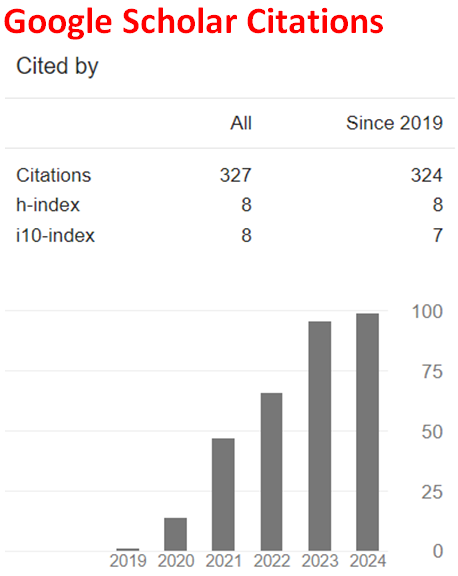Interaction of Biotin Tautomers with Magnesium Dication
Abstract
In the present study, interactions of biotin tautomers and magnesium dication in their composites (in vacuum conditions) have been investigated within the constraints of density functional theory (DFT). Biotin may exhibit 1,3-proton tautomerism. All the composites presently considered have not only exothermic heat of formation values but also favorable Gibbs free energy of formation values. They are electronically stable. Various quantum chemical data have been collected and discussed including UV-VIS spectra. In all the cases, charge of the magnesium cation is less than the initial formal charge of +2 which means that some electron population has been transferred from biotin tautomers to the magnesium cation depending on the tautomeric structure or conformational form. The magnesium cation causes lowering of the frontier molecular orbitals in unequal extents and appears to be more effective on the LUMO energy level in some cases of the composites. Whereas in composite-B, it is more effective on the HOMO energy level. The calculated UV-VIS spectra occur in a large range of wavelengths such that some composites exhibit bathochromic shifts to above 600 nm.
Downloads
References
Bender, D. (1992). Nutritional biochemistry of the vitamins. Cambridge: Cambridge University Press.
Zempleni, J., Wijeratne, S.S.K., & Hassan, Y.I. (2009). Biotin. BioFactors, 35(1), 36-46. https://doi.org/10.1002/biof.8
Dakshinamurti, K., & Chauhan, J. (1989). Biotin. Vitamins & Hormones, 45, 337-384. https://doi.org/10.1016/S0083-6729(08)60398-2
Zempleni, J., & Mock, D.M. (1999). Biotin biochemistry and human requirements. The Journal of Nutritional Biochemistry, 10(3), 128-138. https://doi.org/10.1016/S0955-2863(98)00095-3
McMahon, R.J. (2002). Biotin in metabolism and molecular biology. Annual Review of Nutrition, 22, 221-239. https://doi.org/10.1146/annurev.nutr.22.121101.112819
Taylor, P.J., van der Zwan, G., & Antonov, L. (2013). Tautomerism: introduction, history and recent developments of experimental and theoretical methods. In L. Antonov (Ed.), Tautomerism: methods and theories (pp. 1-19). Weinheim: Wiley-VCH Verlag GmbH.
Nedeltcheva-Antonova, D., & Antonov, L. (2016). Controlled tautomerism: Is it possible? In L. Antonov (Ed.), Tautomerism: concepts and applications in science and technology (Ch.12). New York: Wiley. https://doi.org/10.1002/9783527695713.ch12
Zhang, L., Li, H., Hu, X., & Han, S. (2006).1-NH proton of biotin is not always more active than 3-NH proton. Chemical Physics Letters, 421(4-6), 334-337. https://doi.org/10.1016/j.cplett.2006.01.090
Perrin, C.L., & Dwyer, T.J. (1987). Proton exchange in biotin: a reinvestigation, with implications for the mechanism of carbon dioxide transfer. J. Am. Chem. Soc., 109(17), 5163-5167. https://doi.org/10.1021/ja00251a020
Yi, L., Li, H., Zhang, R., & Han, S. (2007). Theoretical study of cooperativity in biotin. J. Phys. Chem. B, 111(51), 14370-14377. https://doi.org/10.1021/jp076914q
Yi, L., Li, H., Zhang, R., & Han, S. (2004). Molecular dynamics simulations of biotin in aqueous solution. J. Phys. Chem. B, 108(28), 10131-10137. https://doi.org/10.1021/jp049207v
Rana, A., Dey, S., Agrawal, A., & Dey, A. (2015). Density functional theory calculations on the active site of biotin synthase: mechanism of S transfer from the Fe2S2 cluster and the role of 1st and 2nd sphere residues. J. Biol. Inorg. Chem., 20, 1147-1162. https://doi.org/10.1007/s00775-015-1296-9
Chivers, C.E., Koner, A.L., Lowe, E.D. & Howarth, M. (2011). How the biotin– streptavidin interaction was made even stronger: investigation via crystallography and a chimaeric tetramer. Biochemical Journal, 435(1), 55-63. https://doi.org/10.1042/BJ20101593
Abyar, F., & Novak, I. (2018). Electronic structure of biotin conformers studied with SAC-CI and OVGF methods. J. Phys. Chem. A, 122(8), 2079-2085. https://doi.org/10.1021/acs.jpca.7b12631
Emami, M., Teimouri, A., & Chermahini, A.N. (2008). Vibrational spectra and assignments using ab initio and density functional theory analysis on the structure of biotin. Spectrochimica Acta Part A: Molecular and Biomolecular Spectroscopy, 71(4), 1516-1524. https://doi.org/10.1016/j.saa.2008.05.020
Valadbeigi, Y., Farrokhpour, H., & Tabrizchi, M. (2014). DFT study on the isomerization and tautomerism in vitamins B3 (niacin), B5 (pantothenic acid) and B7 (biotin). Chemical Physics Letters, 601,155-162. https://doi.org/10.1016/j.cplett.2014.04.005
Sanchez, E.R., Gessel, M.C., Groy, T.L., & Caudle, M.T. (2002). Interaction of biotin with Mg-O bonds: bifunctional binding and recognition of biotin and related ligands by the Mg(15-crown-5)2+ unit. J Am Chem Soc., 124(9), 1933-40. doi: 10.1021/ja016641r
Stewart, J.J.P. (1989). Optimization of parameters for semi empirical methods I. J. Comput. Chem., 10, 209-220. https://doi.org/10.1002/jcc.540100208
Stewart, J.J.P. (1989). Optimization of parameters for semi empirical methods II. J. Comput. Chem., 10, 221-264. https://doi.org/10.1002/jcc.540100209
Leach, A.R. (1997). Molecular modeling. Essex: Longman.
Kohn, W., & Sham, L.J. (1965). Self-consistent equations including exchange and correlation effects. Phys. Rev., 140, 1133-1138. https://doi.org/10.1103/PhysRev.140.A1133
Parr, R.G., & Yang, W. (1989). Density functional theory of atoms and molecules. London: Oxford University Press.
Becke, A.D. (1988). Density-functional exchange-energy approximation with correct asymptotic behavior. Phys. Rev. A, 38, 3098-3100. https://doi.org/10.1103/PhysRevA.38.3098
Vosko, S.H., Wilk, L., & Nusair, M. (1980). Accurate spin-dependent electron liquid correlation energies for local spin density calculations: a critical analysis. Can. J. Phys., 58, 1200-1211. https://doi.org/10.1139/p80-159
Lee, C., Yang, W., & Parr, R.G. (1988). Development of the Colle-Salvetti correlation energy formula into a functional of the electron density. Phys. Rev. B, 37, 785-789. https://doi.org/10.1103/PhysRevB.37.785
SPARTAN 06 (2006). Wavefunction Inc. Irvine CA, USA.
Reutov, O. (1970). Theoretical principles of organic chemistry, Moscow: Mir Pub.
Anslyn, E.V., & Dougherty, D.A. (2006). Modern physical organic chemistry, Sausalito, California: University Science Books,
Stark, J.G., & Wallace, H.G. (1982). Chemistry data book (2nd Ed.), London: Hodder/Murray.

This work is licensed under a Creative Commons Attribution 4.0 International License.


